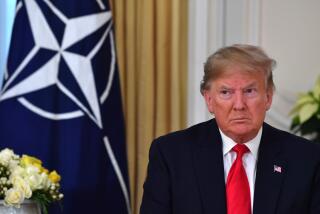Arms Control--the Art of the Impossible
- Share via
PARIS — If politics is “the art of the possible,” arms-control negotiation has become “the art of the impossible.”
Very simply, the United States and the Soviet Union have become adept at making impossible proposals that are designed to gain propaganda advantage and put the other side on the defensive. They have no chance whatever of furthering any realistic prospects of genuine negotiation. It is a tactic used to ensure that nothing happens in arms control but that the other side catches the blame.
The latest example comes from the Soviet Union. After nearly 14 years of deadlock in Vienna in the East-West talks on reducing conventional military forces in Central Europe, Soviet leader Mikhail S. Gorbachev has come up with the brilliant idea that the North Atlantic Treaty Organization and the Warsaw Pact should cut their troop strength by 100,000 to 150,000 men over the next two years.
This is supposed to be taken seriously, even though previously the Soviets had balked at a U.S. proposal for starting with modest cuts of 5,000 American troops and 11,500 on the Soviet side. One is tempted to ask: Whom does Gorbachev think he is kidding?
Actually, the art of the impossible has been practiced for a long time in the field of arms control and disarmament, going back to the 1920s and the effort to limit naval construction by what were then the Great Powers. But it has taken on a heightened form of diplomatic and political play in the past six years, with the Reagan Administration contriving to mount the greatest military buildup in American peacetime history while the arms-control process grinds to a halt with impossible proposals that are supposed to convey forward motion.
The Soviets, of course, have been playing the political and diplomatic game of impossible proposals ever since V. I. Lenin returned to St. Petersburg from Zurich in 1917.
The London-based international Institute for Strategic Studies tartly comments in the new issue of its annual Strategic Survey: “The grand designs of the two sides are curiously similar: Both aim explicitly at the impossible goal of eliminating nuclear weapons--though Mr. Gorbachev, with a straight face, proposes to achieve this revolution in 14 years, while Mr. Reagan’s timescale is not precisely spelled out. To the extent that both leaders know that this goal is unrealizable, they merit the criticism of informed observers for peddling humbug to a gullible and hopeful public.”
The aspiration to eliminate all nuclear weapons tumbles from President Reagan’s lips almost every time arms control comes up for discussion. At his last news conference he gave as one of his reasons for abandoning the SALT II treaty the fact that it was flawed because it failed to make deep cuts in nuclear weapons.
Well, President Jimmy Carter tried. His first move in negotiating SALT II back in 1977 was just such a proposal to the Soviets--deep cuts in the nuclear ceiling that President Gerald R. Ford and Secretary of State Henry A. Kissinger had agreed to with Soviet leader Leonid I. Brezhnev at Vladivostok in 1975. But in the end Carter settled for what was possible, not what was impossible.
As an example of the art of the impossible at work, there was the Reagan Administration’s first move on arms control after taking office in 1981--the famous “zero option” proposal to halt the planned deployment of medium-range nuclear missiles by NATO in Western Europe if the Soviet Union would scrap all of its SS-20 missiles in Eastern Europe. This was devised by Richard N. Perle, the assistant secretary of defense who believes that arms control is about as useful as aspirin is to cure cancer.
Perle knew there was no way that the Soviet Union would agree to scrap its SS-20s. But he reasoned that if the Soviets turned down such an impossible proposal, the NATO allies would have to stiffen up and take the American cruise and Pershing 2 missiles as planned. Perle was right--a classic case of an impossible proposal being put forward to accomplish exactly the opposite of its stated objective.
In the field of chemical weapons, which are under negotiation in Geneva today, the impossibility of inspection and control seems certain to ensure that there will never be any agreement. Now that the United States is embarking on the development and production of binary chemical weapons, there is simply no inspection and control apparatus that could be devised that would be effective. Binary weapons are not deadly until the last moment, when the chemicals are combined. Half the material can be in Colorado and the other half in South Carolina--both harmless. What foolproof control can there be?
It would be possible to halt nuclear testing. Even in the present state of seismic art, neither side could cheat without the other detecting it. It would be possible to agree to defer any deployment of weapons systems in outer space. It is possible to continue the present superpower agreements on the deployment of anti-ballistic missile defense systems. These things are possible--but not so long as the two superpowers go on basing their arms-control policies on the art of the impossible.
More to Read
Sign up for Essential California
The most important California stories and recommendations in your inbox every morning.
You may occasionally receive promotional content from the Los Angeles Times.













